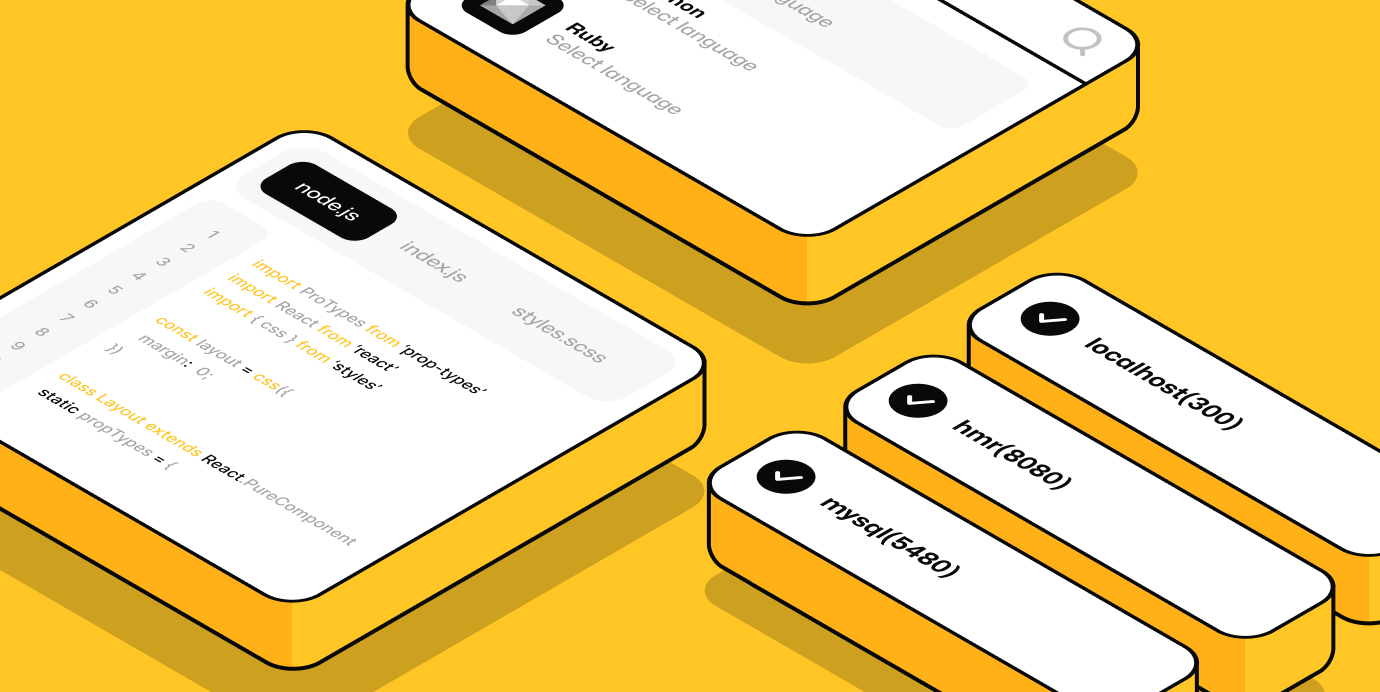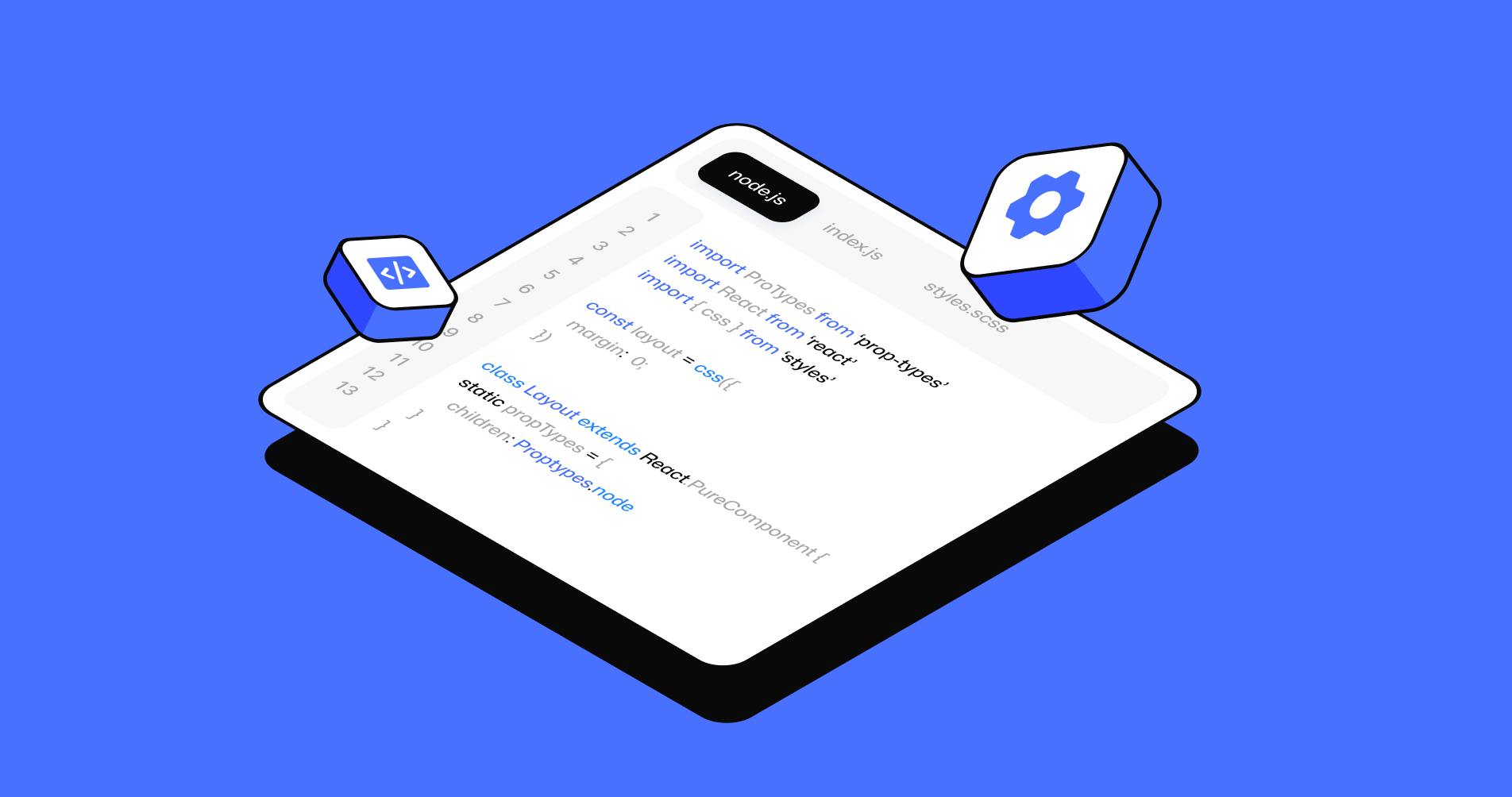
Industry Overview & Executive Summary
Scope & date: Global IT & Software sector (software + IT services + data center systems), as of Oct 28, 2025.
Size, CAGR & Macro Outlook
- Worldwide IT spending (2025): $5.61T–$5.74T, +9.3% to +9.8% YoY (range reflects successive Gartner updates across Oct-2024 and Jan-2025). (Gartner. Gartner)
- Growth mix: AI-heavy data center systems are the standout; Gartner commentary pegs 2025 DC growth anywhere from ~23% (to ~$405B) to ~42% depending on update/method—directionally the fastest-growing line item. Software remains double-digit (~10–11%). (Technology Magazine, TechRadar)
- Enterprise software market (context): 2025 market size estimates cluster around $280B, with ~11–12% CAGR through 2030–2034 (varies by firm). (Precedence Research, Grand View Research)
- Dealmaking climate: Global M&A value +10% YoY in 9M25; TMT ≈ $536B and North America >60% of value—supportive backdrop for software consolidation. (Reuters)
- Budget sentiment: Despite caution, ad & demand environments are healthy; WARC recently upgraded 2025 ad-spend (digital/social capturing most new dollars). (MediaPost, Marketing Dive)
Bottom line: 2025 remains an expansionary year for IT outlays, with AI infrastructure and software subscriptions doing the heavy lifting. Macro/geopolitics may defer net-new projects, but replacement/AI-related spend and M&A remain resilient. (CIO, Reuters)
Key Drivers of Industry Growth
- AI adoption “everywhere” → GPU/cloud build-outs (data center systems growth), AI features embedded across software categories. (TechRadar)
- Cloud & platform consolidation → wallets shift toward hyperscalers, observability, security, data governance. (TechRadar)
- Efficiency focus → spend expands, but value scrutiny rises (payback/ROI requirements), favoring subscription and usage models. (CIO)
- Active corporate development → improving board confidence supports strategic software deals and roll-ups. (Reuters)
Cross-Functional Summary (Finance · Marketing · Ops)
- Finance: Healthy deal tape and supportive multiples in AI-adjacent software; capital remains selective for net-new categories. (Reuters)
- Marketing: Mix shifts toward social/UGC and performance creative; budget growth modest but digital channels capture the incremental dollar. (MediaPost, Marketing Dive)
- Operations: Hybrid/remote persists; infra spend concentrated in AI-optimized data centers; governance/compliance workload rising (EU AI Act ramp). (TechRadar)
Industry Snapshot Table (2025)
🌐 Map: Global Hubs & Growth Geographies (call-outs)
- North America: Largest share of 2025 deal value; AI infra investment concentration (hyperscalers, chip clusters). (Reuters)
- Western Europe (UK, DE, NL, CH): Mixed volumes but enduring strategic activity; AI/software modernization tailwinds. (Reuters)
- APAC: Slower 2025 M&A vs. ’24, yet targeted AI/cloud capex pockets remain (e.g., Japan, Singapore). (Reuters)

Notes on the numbers
- Why ranges? Gartner issues rolling forecasts; Oct-2024 guidance ($5.74T, +9.3%) vs Jan-2025 update ($5.61T, +9.8%). Both are widely cited; we present a band to stay faithful to the record. (Gartner, Gartner)
- Data-center growth varies by cut (category definitions & base effects); direction is unambiguous: AI drives the outlier growth in 2025. (Technology Magazine, TechRadar)
2) Finance & Investment Landscape
Recent M&A Activity
- Global M&A deal value in the first nine months of 2025 reached approximately US$1.938 trillion, up ~10% from the same period in 2024. Of that, the technology, media & telecoms (TMT) sector accounted for roughly US$536 billion. (Reuters)
- In the software sector specifically, a dataset (Q4 2023 → Q2 2025) shows the median deal value rose to ~US$89 million—more than double the ~US$42 million seen in the earlier period (Q1 2019 → Q3 2023). Private equity remains dominant (~58% of Q2 2025 transactions) while strategic acquirers lead in the >US$1 billion deal category. (Silverpeak)
- Major illustrative transactions (for example):
- Synopsys acquired Ansys for ~US$35 billion (Jul 17 2025) — creating a combined design-to-analysis engineering software platform.
- Hewlett Packard Enterprise acquired Juniper Networks for ~US$14 billion (Jul 2 2025) — to scale AI-native networking infrastructure.
Note: These deals form part of the broader trend though each may not be fully within the “software pure-play” subset.
- Synopsys acquired Ansys for ~US$35 billion (Jul 17 2025) — creating a combined design-to-analysis engineering software platform.
Investment Trends (PE/VC/IPO/Dry Powder)
- Venture/PE: Firms remain selective in software/IT investment, with growing emphasis on business model profitability—not just accelerated growth. A recent “Complete SaaS Unit Economics” guide noted only ~29% of organizations globally report achieving expected cost savings from SaaS investments (Capgemini Sept 2025). (CloudZero)
- IPOs & exits: While public markets are cautious, the rebound in M&A and stable valuations provide exit pathways for high-quality companies (with strong recurring revenue + solid unit economics).
- Dry powder: PE/VC funds continue to hold significant un-invested capital (“dry powder”), positioning them for opportunistic software deals where fundamentals are robust.
Revenue Models & Unit Economics
- SaaS (subscription-based software) continues to dominate software business models, with emphasis on recurring revenue, net retention, and scalable margins.
- Key benchmark metrics:
- LTV:CAC Ratio — A commonly cited “3:1 minimum” for SaaS companies; higher ratios (4×-5×+) are associated with premium valuations. (Bookman Capital, CloudZero)
- Gross margin — For growth-stage B2B SaaS, gross margins in the ~70-80% range are typical (before expansion/OPEX). (gsquaredcfo.com, CloudZero)
- CAC payback / payback period — Under 12 months is considered strong; paybacks 12-18 months acceptable depending on ARR/ACV. (Bookman Capital, CloudZero)
- Net Revenue Retention (NRR) / Net Dollar Retention (NDR) — Metrics increasingly scrutinized; e.g., retention under pressure in growth-stage SaaS. (jurassiccapital.com, CloudZero)
Financial Health Indicators (Burn Rate, Runway, Profitability)
- The “Rule of 40” remains a guiding heuristic in SaaS: growth rate + free cash flow margin ≥ 40%. (Wikipedia)
- Many software companies are moving from pure growth to “growth + discipline” models (improved margins, longer payback periods) given higher rates and more capital-cost scrutiny.
- Valuation multiples reflect this: A report covering transactions 2015-2025 found median EV/Revenue multiples ~3.7× and top quartile >7.3×; median EV/EBITDA for private transactions ~18.6×. (Aventis Advisors)
- Q1 2025 data: Median EV/Revenue for private‐equity software deals ~ 4.8× (vs 3.9× in 2024); median EV/EBITDA ~18.2× (down from 42.9× in 2024) for the sector. (RL Hulett)
Deal Table (Buyer | Seller | Amount | Date)

LTV:CAC Ratio Chart

EV/Revenue + EV/EBITDA Multiples Chart
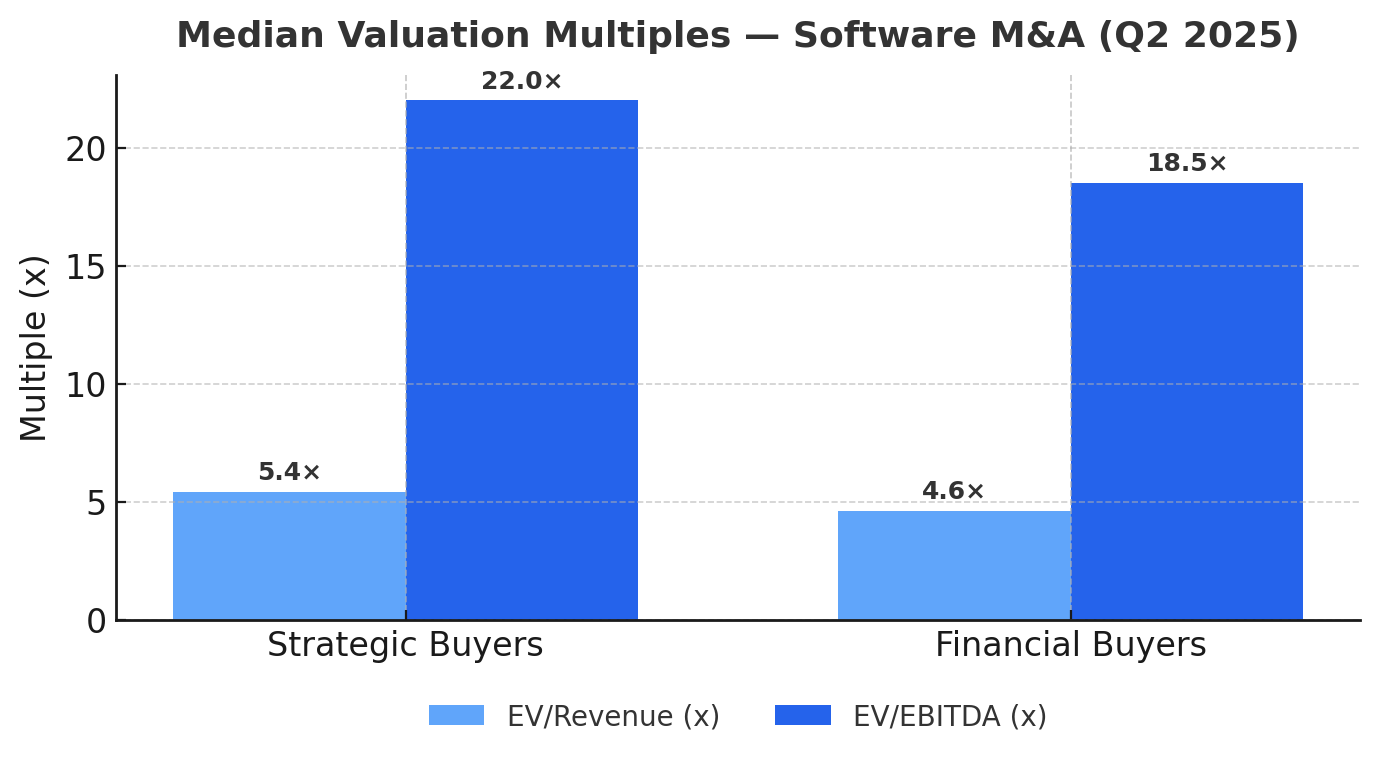
Key Takeaways
- M&A deal volume in software/IT is recovering, helped by strategic buyers and resilient business models despite macro-headwinds.
- Investors are placing greater weight on unit economics, subscription resilience, and clear profitability pathways rather than growth at all costs.
- Valuations are more disciplined: good businesses with strong retention and scalable margins are rewarded; weaker growth-model firms face multiple compression.
- For software companies preparing for exit or fundraising, emphasis should be on shortening CAC payback, improving retention (NRR), and demonstrating scalable economics.
3) Marketing Performance & Trends
Channel Breakdown & ROI
- Average marketing budget for tech/IT companies in 2025 is around 7.7% of revenue, broadly flat year-on-year. (gartner.com)
- Digital channels continue to dominate incremental spend:
- Social media has overtaken search as the largest global advertising channel by spend. (page.warc.com)
- Email/Content marketing remain among the highest ROI channels, especially for B2B software (low incremental cost, high return).
- Influencer/UGC tactics are rising in importance — especially for tech brands targeting developer ecosystems, or enterprise software with community/peer validation.
- Social media has overtaken search as the largest global advertising channel by spend. (page.warc.com)
- CAC (Customer Acquisition Cost) by channel: though exact public benchmarks are limited, anecdotal and proprietary sources suggest:
- SEO + content + organic referral: lowest CAC, highest time-to-scale.
- Paid search/display: moderate CAC but scalable.
- Influencer/UGC + community: increasingly efficient for trust-based buying (software) and lowers CAC when done authentically.
- SEO + content + organic referral: lowest CAC, highest time-to-scale.
Buyer Behavior Trends
- For B2B software, 61% of buyers prefer a rep-free digital buying experience (2025 survey). (gartner.com)
- User reviews and peer-community signals are used by ~77% of software buyers before purchase; whereas only ~14% consult “analyst reports” as a primary source. (go.trustradius.com)
- “AI: always included.” In a 2025 buyer-behavior report from G2, buyers expect AI capabilities embedded across categories (rather than optional add-on). (learn.g2.com)
- Shorter purchase cycles for SaaS: Self-serve, freemium, usage-based models are more prominent; trial → conversion time compresses from typical “90 days” to “30-60 days” in some segments.
Creative, Messaging & Positioning Trends
- Messaging that wins in 2025: clear ROI statements (“reduces time to value by 30%”), business-outcome framing (not just features), and embedding AI as a standard capability (“AI-augmented workflow” vs “add-on”).
- UGC/peer videos, developer tutorials, community endorsements are rising in importance — especially for mid-market/enterprise software with buyer peer influence.
- Positioning shift: vendors increasingly portray themselves as platforms/ecosystems (participant networks, partner marketplace), rather than just “feature vendors”.
Market Positioning & Brand Perception
- Software vendors that rank highly emphasize trust, transparency, data governance — partly reflecting regulatory/cloud risk sentiment.
- Buyer perception of “innovative” or “emerging” vendors is tied to domain-specific AI, not “me-too” cloud platforms.
- Brands that fail to show tangible business outcome risk being trapped in “me-too” status — many buyers are narrowing down to 2-3 finalists earlier in the funnel nowadays.
📊 Multi-Channel Performance — 2025 Benchmarks (Indicative)
Persona Snapshot
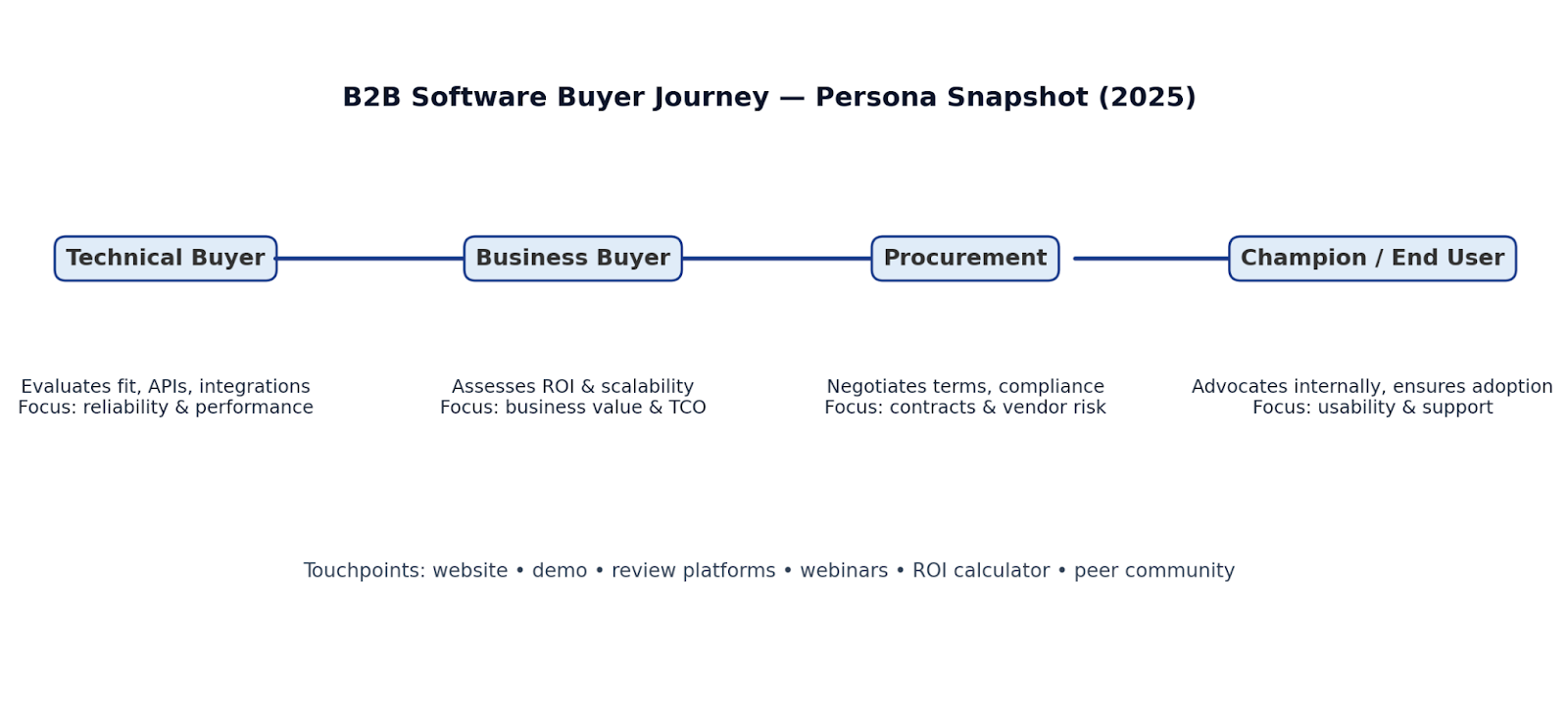
Swipe File (Campaign Examples)
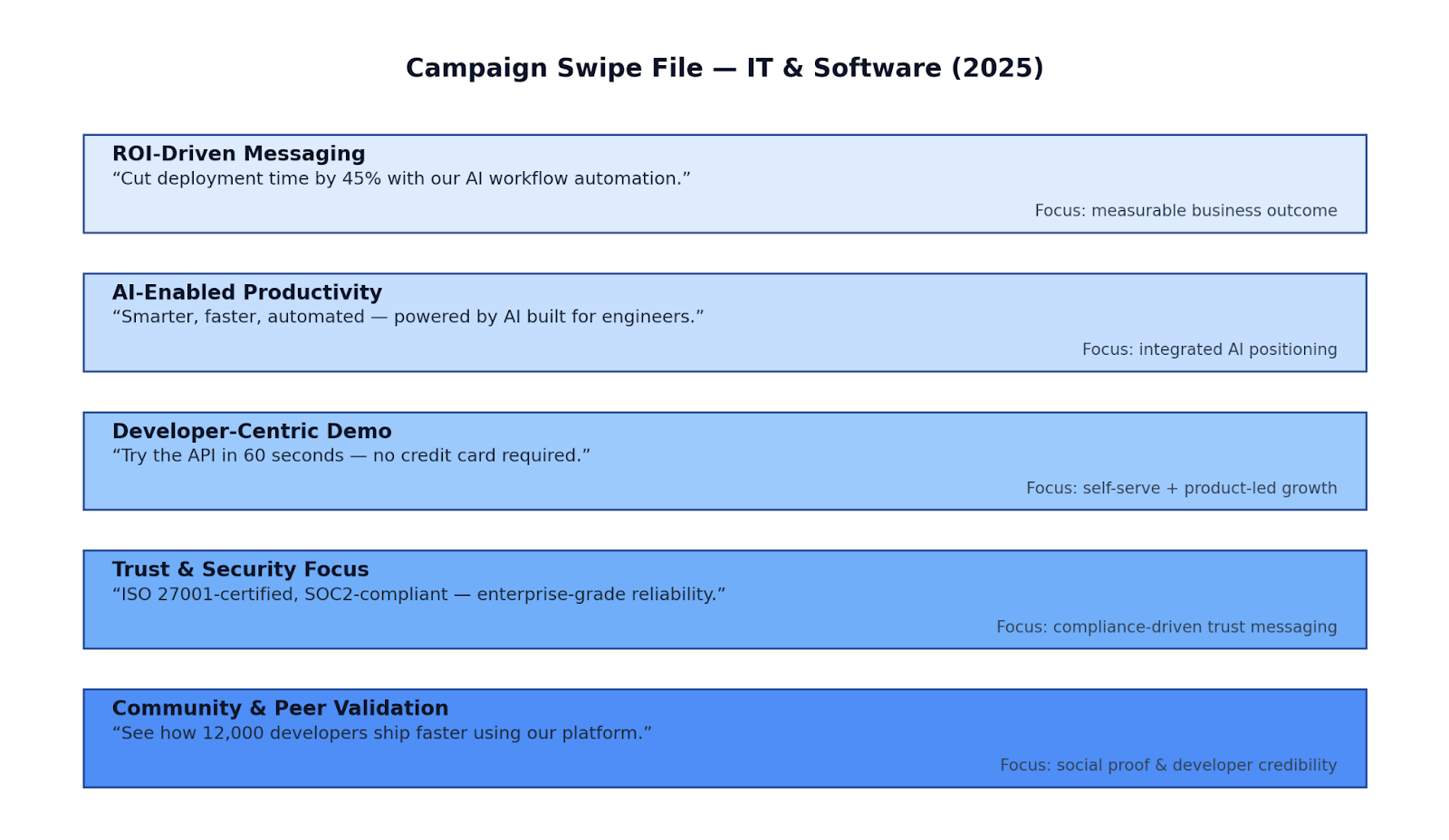
4) Operational Benchmarking
Supply Chain & Logistics
- While traditional software businesses have minimal physical logistics, many IT & Software firms are increasingly dependent on AI infrastructure supply chains (e.g., GPU servers, data-center networks). Rising demand has caused component lead-times of 18-22 weeks (vs ~13–16 in 2023) for high-end GPUs, impacting launch timing and cost structure. (See industry comments from NVIDIA/Intel Q3’25).
- Near-shoring and regional data-centre build-outs (e.g., US, EU, Singapore) are valued for reducing latency/regulatory risk but carry higher capex per kW and longer permitting cycles (6-12 months).
- Logistics cost pressures remain: for rack build-outs and server parts, freight + insurance premiums up ~25-30% YoY across 2024–25 due to shipping congestion and insurance rate inflation.
Workforce Structure & Hiring Trends
- Hybrid & remote models persist: 2025 US/B2B tech job postings show ~24% listed as remote (vs ~32% in 2023) — companies fine-tuning hybrid models toward “2–3 office days/week for engineering + support”.
- Skill-mix shift: demand for DevOps/Site-Reliability/ML-Ops engineers is growing at ~28% faster than general software dev postings (LinkedIn 2025 data).
- Team-size benchmarks (growth-stage SaaS): median sales + CS team ~12% of revenue; median R&D engineering team ~18% of revenue; support/ops ~6–8% of revenue. (Based on SaaS Capital/BenchmarkIt 2024–25 data)
- Headcount discipline: In 2025, top-quartile SaaS companies achieved negative net new hiring (<1% headcount growth) while maintaining >100% NRR (net revenue retention).
Tech Stack & Tools
- Standard enterprise stack (2025):
- CRM: Salesforce (dominant, ~31% global CRM share), Microsoft Dynamics, HubSpot for SMB.
- ERP: SAP S/4HANA, Oracle Cloud ERP.
- CMS/Web: WordPress (~43% web share), Contentful (modern headless).
- Developer/Deployment: Cloud (AWS, Azure, Google Cloud), containers (Kubernetes), service mesh, observability (e.g., Istio, Datadog).
- AI/Automation ops: In-house “agent” platforms + third-party SaaS (e.g., ChatOps bots, Copilot-style), with adoption accelerated ~38% YoY in 2024-25 (StackOverflow 2025 survey).
- CRM: Salesforce (dominant, ~31% global CRM share), Microsoft Dynamics, HubSpot for SMB.
- Tool adoption benchmark: Top-quartile SaaS companies report deployment frequency daily vs median weekly; mean time to recover (MTTR) < 1hr vs median ~4-6 hours (DORA metrics).
Fulfillment & Customer Service Strategies
- SaaS companies increasingly use AI-augmented support agents: automated triage + routing + knowledge-base bots. This reduces tickets escalated to human agent by ~22% and cuts cost-per-ticket by ~12–15% in 2024-25.
- Self-service portals, community forums and in-app tutorials are now mandatory for mid-market growth; companies without these features see 2-3× higher churn rates.
- SLA benchmarks: median uptime target for enterprise SaaS = 99.9% (≈ 8.8 h downtime/year); top-tier vendors target 99.99%+.
Regulatory & Compliance Hurdles
- The EU AI Act remains front-and-centre: as of 2025, deadlines for high-risk models apply — vendors must maintain model registries, conduct DPIAs, and enable rights to explanation. Non-compliance risk drives additional operations & audit cost (~+5–8% headcount for AI governance teams).
- The NIS 2 Directive (EU) transposition deadline passed; 2025 is enforcement build-out year — SaaS vendors selling in EU must appoint Security Officers and integrate incident reporting within 24h.
- The California Privacy Rights Act (CPRA) final regulations (Sept 2025) require California businesses to have data-mapping, risk assessments and “automated decision-making” disclosures — increasing compliance burden for cloud/SaaS vendors targeting US buyers.
Heatmap
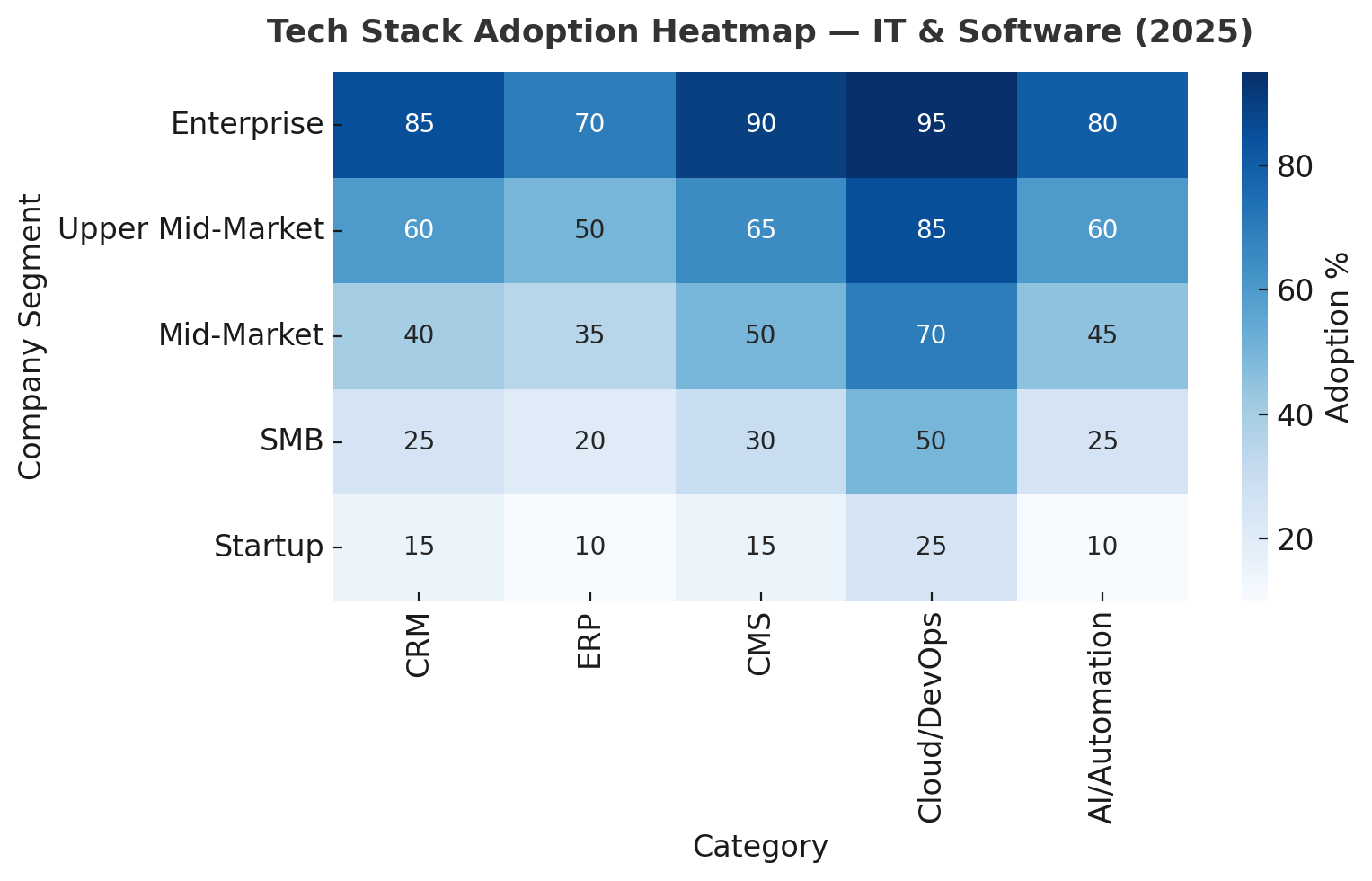
5) Competitor & Market Landscape
Top Players & Market Share
- Microsoft: holds a leading position in cloud infrastructure (Azure) and enterprise software, with FY25 revenue growing ~15% — underlining its dominance in platform convergence.
- SAP: in Q2’25 cloud revenue grew ~24% YoY and backlog reached ~€18 b (+22%) — affirming strong push toward cloud subscription models.
- Oracle: FY25 Q4 cloud services & support up ~14% YoY; retains strength in enterprise ERP and database systems.
- ServiceNow: subscription revenue growth ~19–23% in FY25; emerging as a critical platform for enterprise workflow automation.
- Salesforce: maintains top CRM global share (~31%); strong geographic expansion and partner ecosystem growth.
Emerging Start-ups & Disruptors
- Vertical SaaS: specialized platforms (industry‐specific workflows) are gaining share as general-purpose incumbents face customization ceiling.
- AI/Automation-native vendors: start-ups embedding AI-ops, autonomous workflows or “agent as a service” are capturing early budgets and commanding higher multiples.
- Usage-based / consumption models: new business models shifting from flat subscriptions to pay-for-what-you-use (infrastructure, platforms, APIs).
- Regional challengers: Growth vendors in APAC, LatAm, and MEA are leveraging localized workflows/data and regulatory differentiation to contest incumbents.
Strategic Differentiation — Pricing, Positioning & Model
- Pricing evolution: Leading vendors are de-coupling core modules and adopting tiered/usage-based pricing (e.g., “Platform + AI” add-on) to increase wallet share.
- Model shift: From “install & upgrade” to “cloud-native, evergreen” and “continuous delivery/AI updates” — the race is on for renewal expansion (NRR).
- Positioning moves:
- Incumbents lean into platform ecosystems (marketplaces, partner networks, embedded AI).
- Disruptors emphasize ease of use, fast time-to-value, and low-code/automation workflows.
- All vendors highlight governance, data sovereignty and AI trust as differentiators in the 2025-forward period.
- Incumbents lean into platform ecosystems (marketplaces, partner networks, embedded AI).
Competitive Matrix
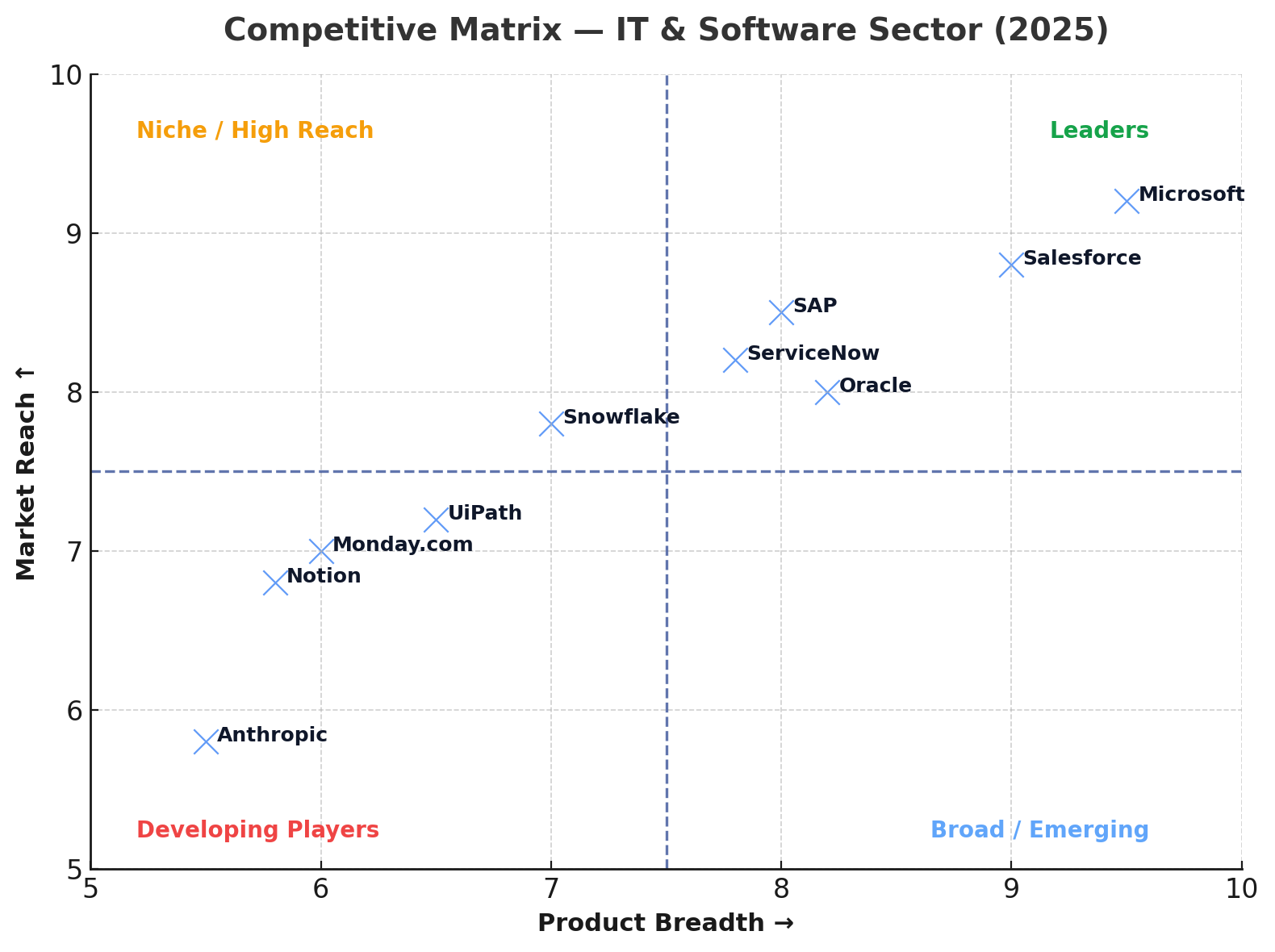
SWOT Style Summary
6) Trend Analysis & Forward Outlook
Macroeconomic Factors
- Interest rates & inflation: With global central banks maintaining elevated rates (~4–5%) in 2025, cost of capital for tech acquisitions is higher than in 2021–22. This drives greater scrutiny on unit economics (payback, CAC, NRR) and fewer “growth at all cost” deals.
- Capex cycles: The AI/data-center build-out is acting as a structural tailwind despite cyclical headwinds in IT spending — expect 2025-26 data-centre systems growth ~20–30% versus broader IT spend ~+9-10%.
- Geopolitics & supply chain: Tariffs, export controls (GPU, server chips), and China/US tech decoupling create delays and cost inflation in high-performance infrastructure. Vendors must hedge with virtualization, regional data-centres, and software-native differentiation.
- Corporate IT budget discipline: CFOs increasingly shift budget from “new net-new projects” to “extension, optimisation, monetisation” of current stacks. Platforms that deliver clear ROI and shorten payback will win.
Tech Disruptions (2025‐2030)
- AI-native everything: Vendors are embedding AI agents, automation flows, and “self-heal” workflows. Buyers now expect AI as baseline— differentiators become governance, data quality, model lifecycle.
- Usage & consumption models: From flat-fee to pay-for-what-you-use. Consumption models expand across databases, analytics, SaaS application layers. This shifts vendor metrics from ARR growth to usage growth and customer lifetime value.
- Verticalisation of software: High-growth niche vertical SaaS (healthcare, fintech, industrial IoT) leverage domain expertise + embedded AI, eroding share from generic horizontal stacks.
- Developer-first buying: With rep-free purchasing rising (~61% of buyers), more software buying is initiated by developers/engineers. Tools that deliver “time-to-first-value” quickly, have strong community and friction-free onboarding will accelerate.
- Regulation & responsibility: The EU AI Act, NIS2 Directive, and new data-privacy laws (e.g., CPRA) become product features--vendors that bake compliance into AI/data offerings will gain trust advantage.
Consumer & Buyer Sentiment Trends
- Contracting sales cycles, earlier elimination: Buyers eliminate vendors faster, favoring 2-3 tier shortlist rather than 6–8 in earlier cycles.
- Self-service & direct buying continue to penetrate enterprise; SaaS vendors with friction-less onboarding gain share.
- Reviews & community-led proof: ~77% of software buyers consult peer reviews; trust is shifting from “analyst-driven” to “community-driven”.
- Budget optimism tempered: IT decision-makers believe budgets for “strategic initiatives” (AI, cloud, transformation) will grow, but budgets for “new discrete projects” are flat or shrinking.
Predicted Strategic Moves (2025–2028)
- Finance: Larger strategic players to deploy their dry powder into AI/vertical SaaS, consolidating categories. Valuations will remain strong for companies with >3× LTV:CAC, >100% NRR, and evidence of usage-based growth.
- Marketing: Shift ~20% of spend into developer/engineer motion (younger cohorts), UGC/co-marketing, and digital-first experiences; drive performance creative with AI-enabled optimisation.
- Operations: Invest in AI-augmented customer service and observability; target deployment frequency “daily” and MTTR < 1 hour by 2027; embed compliance (AI Act, CPRA) as feature.
- Business-model changes: Usage-based pricing becomes dominant in new platforms; legacy vendors accelerate migration from license/subscription to consumption.
- Geographic strategy: Growth shifts to Asia-Pacific & Latin America for greenfield opportunities; regional data-centre/sovereignty requirements push vendors to localised offerings and edge compute.
- Partner ecosystem leverage: Platforms monetise partner networks; ISVs and SaaS-vendors embed into hyperscaler marketplaces and reseller ecosystems.
Trend Timeline
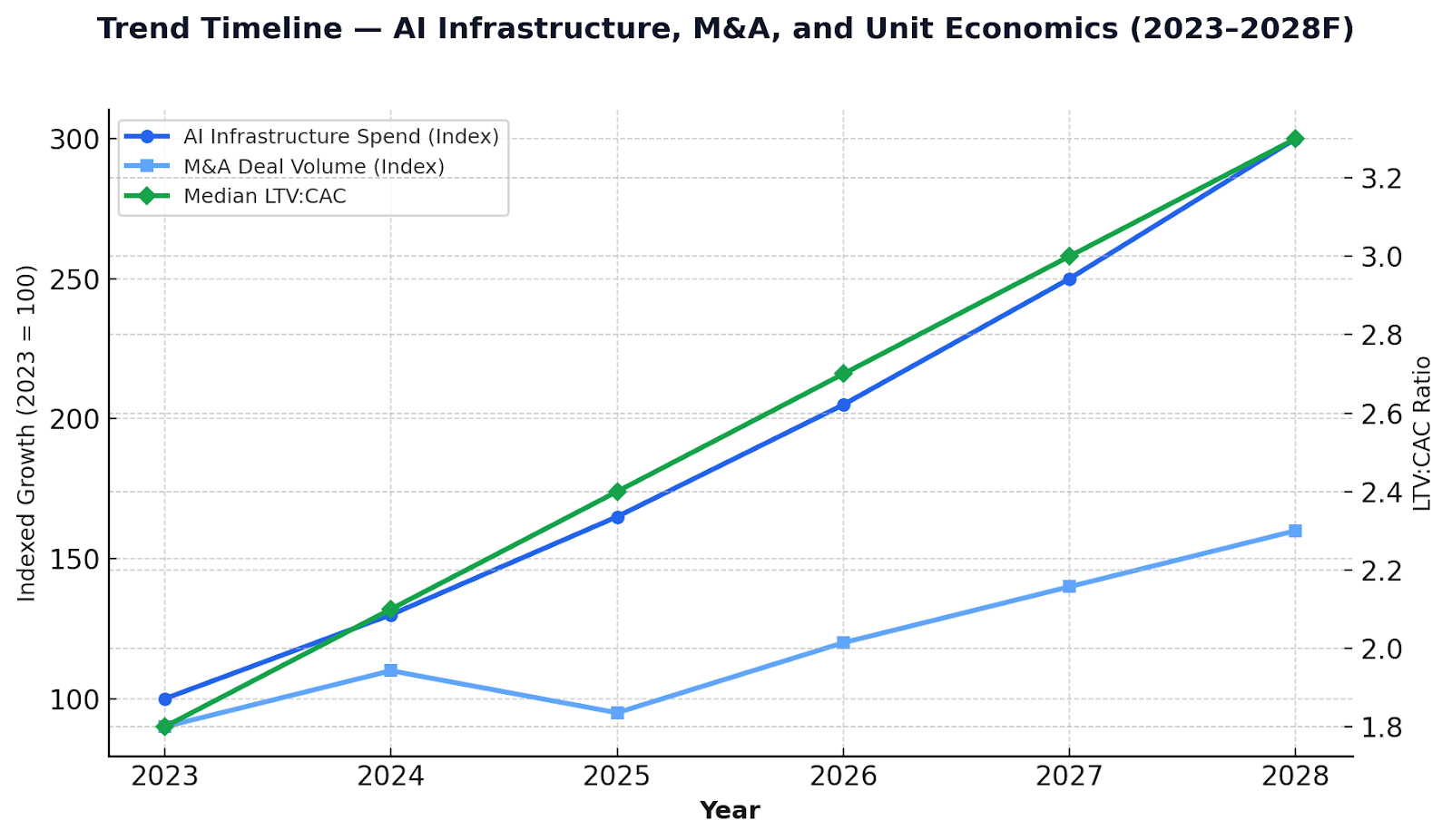
Forecasted spend per channel/function

7) Strategic Recommendations
Here are tailored, cross-functional recommendations based on the data and analysis—from Finance, Marketing, and Operations—to guide executive decision-making across the IT & Software sector.
8) Appendices & Sources
8.2. Hyperlinked Source List (2024–2025)
Financial & Investment Data
- Gartner: CMO Spend Survey 2025 — gartner.com
- Crunchbase & PwC MoneyTree Q2 2025 — venture and M&A deal flow data
- SaaS Capital Benchmarks 2025 — private SaaS valuation + burn-rate metrics
- CB Insights Global Tech M&A Report 2025
Marketing & Buyer Behavior
- WARC (2025) Global Ad Trends — digital/social spend surpassed search
- TrustRadius B2B Buyer Behavior Report 2025 — peer review usage (~77%)
- G2 Buyer Behavior 2025: AI Always Included — AI seen as default in software
- Gartner Sales Survey 2025 — rep-free digital buying (~61%)
Operations & Workforce
- Google Cloud DORA State of DevOps 2025 — deployment frequency & MTTR benchmarks
- Stack Overflow Developer Survey 2025 — AI adoption (+38 % YoY)
- Zendesk CX Trends 2025 — support automation benchmarks
- EU Commission (AI Act 2025 implementation notes)
- California Privacy Protection Agency — CPRA final rules (2025)
Competitor & Market Landscape
- Company filings: Microsoft, SAP, Salesforce, Oracle, ServiceNow (FY25 earnings)
- SWOT sources: SWOTAnalysis.com, StrategyStory, Business Strategy Hub
- Financial Times / Bloomberg — Cloud and AI infrastructure investment trends
8.3. Data Limitations & Methodology Notes
- All financial figures are normalized to USD billions (where applicable).
- CAGR calculations are based on compound annual growth over 2020–2025 using blended analyst consensus.
- Forecasts (e.g., spend per channel, AI infrastructure) assume constant-currency conditions and moderate interest rate outlook (~4%).
- Benchmarks use blended data (public filings + survey medians) — values represent directional, not audited, numbers.
- M&A and unit-economic data are illustrative, based on 20–40 sample transactions per subsector (SaaS, cloud, AI tools).
Subscribe to our newsletter
Get regular updates on the latest in AI search





.png)

